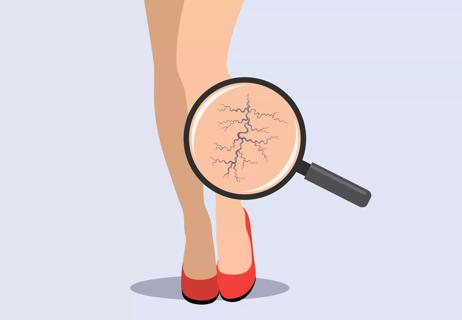Some symptoms should be taken seriously

For some people, the biggest concern about varicose veins is the way they look. But there are possible links between varicose veins and serious health problems involving blood clots in the deeper veins of your legs.
Advertisement
Cleveland Clinic is a non-profit academic medical center. Advertising on our site helps support our mission. We do not endorse non-Cleveland Clinic products or services. Policy
Douglas Joseph, DO, Director of Cleveland Clinic’s Vascular Medicine Outpatient Department, offers his best advice on how to limit the impact of varicose veins and when you should be concerned.
Varicose veins are abnormal blood vessels that typically develop in your legs and feet. They look like bulging, twisted clusters of blue or purple veins. Faulty valves and increased pressure in your legs can cause vessel walls to weaken and veins to swell and protrude, Dr. Joseph explains.
They’re more likely to develop as you age, but if you have weakened valves in your veins, you can get varicose veins as early as your teens. They’re fairly common — some estimates say between 30% and 50% of adults may develop them.
Risk factors include:
Many people might not have any symptoms, but some might.
You may experience quality-of-life issues, like your varicose veins bother you more at the end of the day — especially if you stand on your feet a lot or sit for long periods of time. Other symptoms that might happen on a daily basis include:
Advertisement
In some cases, the condition can lead to more serious health issues. If you’re experiencing pain or showing symptoms, you may want to get evaluated.
Usually, varicose veins aren’t dangerous, but they can present problems the longer you have them. Having varicose veins may increase your risk of developing deep vein thrombosis or a pulmonary embolism.
Deep vein thrombosis happens when a blood clot forms in one of the deep veins in your body. It can cause leg pain and swelling.
If a blood clot breaks away and travels to your lungs, it is known as a pulmonary embolism. This is a life-threatening condition that requires immediate medical attention. Symptoms may include chest pain and shortness of breath.
You can also develop what’s called superficial thrombophlebitis, which means you have a blood clot in your vein just under the skin. In most cases, this kind of clot won’t travel to your lungs. But it can cause severe, sharp pain along the surface of your vein and your vein may feel hardened and appear red.
If you experience an increase in swelling or pain in your legs, this may be a sign of a serious problem, especially if these symptoms come on suddenly.
Another sign of worsening symptoms is if your skin becomes discolored, turns brown or red, and becomes hot or painful. A change in skin color can be a result of chronic inflammation caused by the elevated pressure in your veins. Initially, it may appear red, but over several months, your skin could turn brown.
“The best thing you can do is reverse that elevated pressure,” says Dr. Joseph.
You can do this by wearing compression socks, elevating your legs and exercising on a regular basis. Dr. Joseph recommends moderate exercise such as cycling, running or swimming four or five times per week. He also suggests maintaining a body mass index of 25 or less.
“Removing those varicose veins on the surface or using ultrasound to identify the source that’s feeding into those varicose veins and treating that can help as well,” he adds.
If you’ve had varicose veins for a long time, you might also develop small veins very close to the surface of your skin in your lower legs, and these can often become vulnerable to minor cuts or wounds. Even drying yourself off with a towel can break your skin and cause a vein to bleed.
“Because of the elevated pressure in your veins, it can bleed very quickly,” says Dr. Joseph. “If this happens to you, this can be treated by elevating your leg and applying direct pressure over the site of bleeding. If bleeding persists, you should seek medical attention.”
You can also develop ulcers, sores and infections if left untreated.
“Once you have varicose veins, wearing compression hose during the day can help symptoms by improving blood flow in the veins,” says Dr. Joseph. Elevating your legs after prolonged walking or standing can also help improve blood flow.
Advertisement
If you try these tips and continue having bothersome symptoms, make an appointment with a vascular specialist who can talk to you about low-risk procedures that can help relieve varicose veins.
“If you see you have varicose veins and you experience any of these symptoms, it’s a good idea to talk to your doctor about it,” encourages Dr. Joseph.
Advertisement
Learn more about our editorial process.
Advertisement

Home remedies can improve (but not cure) the symptoms and appearance of varicose veins

Unlike varicose veins, spider veins don't necessarily indicate poor circulation

Treating them can improve your vascular health

Most recommended precautions center around minimizing bruising or swelling

Even one drink can have an impact on your cognitive function leading to slurred speech, blurred vision and impaired memory

Understand who may (and may not) benefit

Type 2 diabetes isn’t inevitable with these dietary changes

Applying a hot or cold compress can help with pain